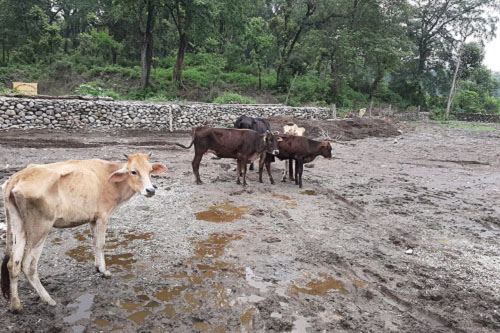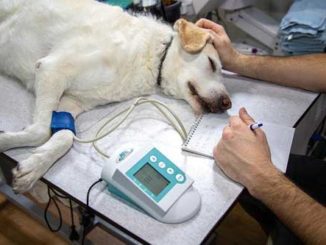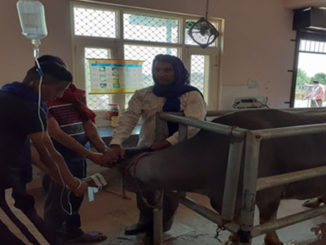Introduction
Listeriosis is a sporadic bacterial infection that affects a wide range of animals like cattle, buffalo, goat, pigs as well as humans and birds. The disease is also sometimes referred to as silage sickness due to its association with the ingestion of silage with a pH of 5-5.5, poorly fermented silage, or otherwise healthy silage that has deteriorated aerobically. Winter and early spring are the seasons with the highest prevalence. Some of the common signs are abortion, circling movement, unilateral facial paralysis. Encephalitis or meningoencephalitis, abortion, septicemia in adult ruminants is the most frequently recognized forms. It is transmitted by faeco-oral route, spoiled silage, and transplacental. Listeriosis in humans is usually a food borne disease. Listeriosis is distributed worldwide. The disease is more prevalent in temperate countries as compared to tropical and subtropical countries. It is primarily a winter-spring disease of feedlot or housed ruminants. There is a high incidence of intestinal carriers. It is often associated with stored forages, usually silage. Removal or change of silage in feed rations often stops the spread of listeriosis; however, feeding the same silage months later may result in new cases.

Etiology
Listeriosis is caused by the bacterium belongs to genus Listeria. The organism may be found in a range of environments, including water, soil, rotting vegetable matter, sewage, and a variety of foods. It is a small, motile, gram-positive, nonspore-forming, extremely resistant, diphtheroid coccobacillus that grows in a wide temperature range 39–111°F. Two of the 17 Listeria species are reported to be present. L. monocytogenes and L. ivanovil are pathogenic bacteria. L. monocytogenes is pathogenic to both humans and animals, whereas L. Ivanovil is mostly pathogenic to animals and causes disease in humans occasionally. Listeria has been isolated from at least 42 species of domestic and wild mammals and 22 species of birds.
Susceptible host
Listeria can infect a broad range of animal species; however, it is mostly responsible for ruminant disease. Sheep and cattle are most susceptible, while infection in goats, swine, horses, and poultry is uncommon. Septicemic form is most common in young ones and monogastric animals. Reduced host animal resistance, inadequate nutrition, rapid changes in weather, stress due to late pregnancy, parturition, or transport, and lengthy durations of silage feeding are all circumstances that predispose the animal to the disease.
Mode of transmission
The main cause of listeriosis is the spoiled silage. The less acidic pH of spoiled silage (pH>5.5) enhances multiplication of bacteria. The natural reservoirs of L. monocytogenes appear to be soil and mammalian GI tracts, both of which contaminate vegetation. Grazing animals ingest the organism and further contaminate vegetation and soil. Animal-to-animal transmission occurs via the fecal-oral route. Young ones may acquire infection through milk from dam.
Pathogenesis
Listeria organisms that are ingested or inhaled tend to cause septicemia, abortion, and latent infection. Those that gain entry to tissues have a predilection to localize in the intestinal wall, and through lacerated buccal mucosa it gains entry in trigeminal nerve and travels to central nervous system and localize in medulla oblongata. This results in involuntary circling movements of the animal. When it reaches into blood circulation, it causes septicaemia. Once it enters into blood circulation it enters into uterus or placenta and causes abortion in the last trimester and into udder to cause mastitis.
Clinical findings
Listeriosis is referred to as circling disease in animals because it manifests as circling in ruminants affected by encephalitis along with other neurological symptoms such as animal moves in a circling pattern, ataxia, opisthotonus, head deviation, head tilting, and cranial nerve paralysis, hyperthermia as well as unilateral facial paralysis along with the drooling of saliva can be observed. Dropping of ears and eyelids of the paralyzed side is observed. Encephalitis is the most often seen clinical manifestation in ruminants. However, abortions, stillbirths, retained placental membranes, and unusual signs such as conjunctivitis have been seen. Septicemic listeriosis may present with or without meningitis and is most often found in newborn ruminants as well as adult sheep and goats.
Lesions
In listeric encephalitis, there are few gross lesions except for some congestion of meninges. In septicemic listeriosis, small necrotic foci may be found in any organ, especially the liver. In calves that die at age less than 3 weeks, there is frequently marked hemorrhagic gastroenteritis observed. Aborted fetuses typically include slight to marked autolysis, clear to blood-tinged fluid in serous cavities, and numerous small necrotic foci in the liver.
Diagnosis
Diagnosis can be made based on clinical manifestation and previous history of spoiled silage consumption. The organism may be isolated from the placenta, foetus, or uterine discharges after abortion; from the blood of septicemic animals; or from postmortem tissue samples including the liver, spleen, kidneys, and brain. Specialized enrichment approaches, on the other hand, are required to collect organisms from contaminated materials such as faeces or food, as well as from the brain, where they appear in low levels. Additionally, molecular technologies such as PCR may be used. Differential diagnosis with other neurological diseases such as pregnancy toxaemia in sheep, nervous ketosis, rabies, polioencephalomalacia, and scrapie in cattle is required.
Treatment
It can be treated by various drugs:
- penicillin’s (22,000 U/kg weight every 12 hours for 1-2 weeks I/V) are the most often used antibiotics for listeriosis, however other antibiotics such as tetracyclines are also prescribed.
- Chlortetracycline at 10mg/kg BW/day for 5 days is advised, followed by injectable penicillin at 44000 IU/kg BW, I/M daily for 7 days or 10-14 days.
- Dexamethasone (1 mg/kg, IV) in initial days is beneficial.
- In addition, supportive medication with parenteral fluids, neurotropic vitamins, and minerals is given. It is essential to feed high-quality silage to ruminants to prevent listeriosis.
Control
- Since silage with Listeria development can appear normal, the surface few inches exposed to air, as well as any spoiled or mouldy silage, should not be given to the animals.
- To avoid cross-contamination, remaining silage should be removed after feeding and silage handling tools washed. Supportive therapy, including fluids and electrolytes, is required for animals having difficulty eating and drinking.
- Affected animals should be segregated.
- Spoiled silage (pH>5.5) should be avoided.
- Vaccination is not effective as it is an intracellular organism.
- Proper incineration of aborted fetus.
- Prevent consumption of milk of affected animal.
| The content of the articles are accurate and true to the best of the author’s knowledge. It is not meant to substitute for diagnosis, prognosis, treatment, prescription, or formal and individualized advice from a veterinary medical professional. Animals exhibiting signs and symptoms of distress should be seen by a veterinarian immediately. |








Be the first to comment